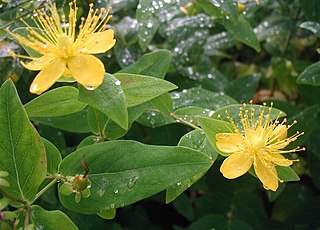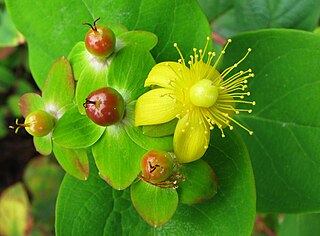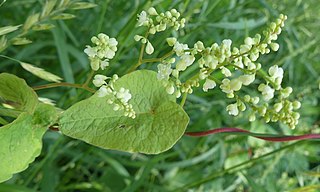
In biology, a tribe is a taxonomic rank above genus, but below family and subfamily. It is sometimes subdivided into subtribes. By convention, all taxa ranked above species are capitalized, including both tribe and subtribe.

The International Code of Nomenclature for algae, fungi, and plants is the set of rules and recommendations dealing with the formal botanical names that are given to plants, fungi and a few other groups of organisms, all those "traditionally treated as algae, fungi, or plants". It was formerly called the International Code of Botanical Nomenclature (ICBN); the name was changed at the International Botanical Congress in Melbourne in July 2011 as part of the Melbourne Code which replaced the Vienna Code of 2005.
In botany, the correct name according to the International Code of Nomenclature for algae, fungi, and plants (ICN) is the one and only botanical name that is to be used for a particular taxon, when that taxon has a particular circumscription, position and rank. Determining whether a name is correct is a complex procedure. The name must be validly published, a process which is defined in no less than 16 Articles of the ICN. It must also be "legitimate", which imposes some further requirements. If there are two or more legitimate names for the same taxon, then the correct name is the one which has priority, i.e. it was published earliest, although names may be conserved if they have been very widely used. Validly published names other than the correct name are called synonyms. Since taxonomists may disagree as to the circumscription, position or rank of a taxon, there can be more than one correct name for a particular plant. These may also be called synonyms.
In botanical nomenclature, a hybrid may be given a hybrid name, which is a special kind of botanical name, but there is no requirement that a hybrid name should be created for plants that are believed to be of hybrid origin. The International Code of Nomenclature for algae, fungi, and plants (ICNafp) provides the following options in dealing with a hybrid:

Coleus barbatus, also known by the synonyms Plectranthus barbatus and incorrectly Coleus forskalaei, is a tropical perennial plant related to the typical coleus species. It is known by the common name woolly plectranthus. It produces forskolin, an extract useful for pharmaceutical preparations and research in cell biology.
Galium hardhamiae is a species of flowering plant in the coffee family Rubiaceae, known by the common name Hardham's bedstraw. The scientific name may be misspelled Galium hardhamae. It is endemic to the Santa Lucia Range of southern Monterey County and northern San Luis Obispo County in California. It is a member of the serpentine soils flora in these coastal mountains. This is a perennial herb forming mats or clumps of stems no more than 30 centimeters long. The stems have many whorls of six fleshy green leaves, each leaf just 1 to 3 millimeters long. The inflorescences, clusters of yellow-green to pinkish flowers, appear in leaf axils.

Vriesea wawrana is a plant species in the genus Vriesea. This species is endemic to Brazil.
The Kew Rule was used by some authors to determine the application of synonymous names in botanical nomenclature up to about 1906, but was and still is contrary to codes of botanical nomenclature including the International Code of Nomenclature for algae, fungi, and plants. Index Kewensis, a publication that aimed to list all botanical names for seed plants at the ranks of species and genus, used the Kew Rule until its Supplement IV was published in 1913.

Cranfillia fullagari, synonym Blechnum fullagarii, is a fern in the family Blechnaceae. The specific epithet honours James Fullagar, who collected plants on Lord Howe Island for the Royal Botanic Gardens, Melbourne.

Quercus margarettae, the sand post oak or dwarf post oak, is a North American species of oak in the beech family. It is native to the southeastern and south-central United States from Virginia to Florida and west as far as Texas and Oklahoma. There are historical reports of the species growing in New York State, but it has not been seen there in years.
Hypericum collinum is a flowering plant in the family Hypericaceae which is found in Mexico.

Hypericum hircinum is a species of perennial flowering plant in the St John's wort family, Hypericaceae. It is known as goat St John's wort and stinking tutsan; both names refer to the plant's distinctive odor. The species is a bushy shrub that can grow up to 1.5 meters tall, is many-stemmed, and has golden yellow flowers with conspicuous stamens. The plant has been well-documented in botanical literature, with mentions dating back to at least 1627. Carl Linnaeus described H. hircinum several times, including in his 1753 Species Plantarum which established its binomial. At one point the plant was placed into the defunct genus Androsaemum, but it was returned to Hypericum by Norman Robson in 1985.

Androsaemum, commonly called tutsan, is a section of flowering plants in the family Hypericaceae. It is made up of Hypericum androsaemum, H. foliosum, H. grandifolium, and H. hircinum, as well as the hybrid H. × inodorum. When it was first described, it was considered its own independent genus, but was later placed under Hypericum and demoted to a section. It is also the namesake of an "Androsaemum-group" of related taxa that includes several other sections of Old World species. The Latin name Androsaemum comes from a Greek work to describe plants with red sap, and literally means "blood-man".

Polygonum ciliinode is a species of flowering plant in the family Polygonaceae, native to central and eastern Canada, and the north-central and eastern United States. The specific epithet is also spelt cilinode.
Iris Sheila Collenette was a British botanist, plant collector, and author noted for her work on the flora of Saudi Arabia, particularly her books An illustrated guide to the flowers of Saudi Arabia and Wildflowers of Saudi Arabia. The species Aloe sheilae and Rhytidocaulon sheilae were named in her honor. She collected the holotype of Hypericum collenetteae, named by Norman Robson. She identified at least fourteen species. The standard author abbreviation Collen. is used to indicate this person as the author when citing a botanical name.

Hypericum coadunatum is a species of flowering plant of the St. John's wort family (Hypericaceae) that is found in the Canary Islands.
Hypericum psilophytum is a species of flowering plant of the St. John's wort family (Hypericaceae) that is found in Morocco and Algeria.
Hypericum scruglii is a species of flowering plant of the St. John's wort family (Hypericaceae) that is found in Sardinia.
Hypericum somaliense is a species of flowering plant of the St. John's wort family (Hypericaceae) that is found in Somalia.

Hypericum tomentosum is a species of flowering plant of the St. John's wort family (Hypericaceae) that is found in the western Mediterranean.











